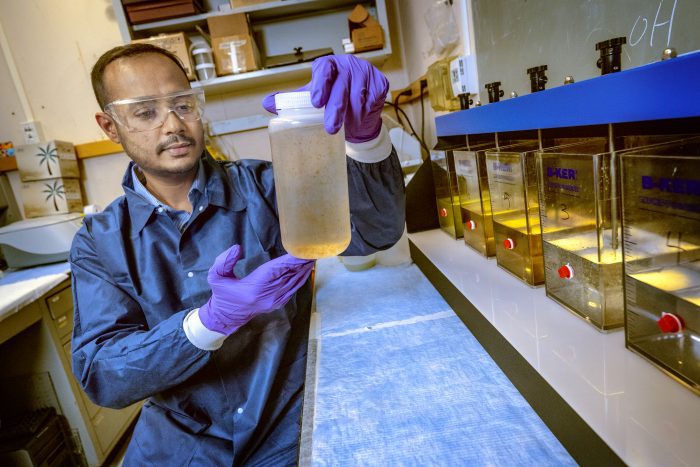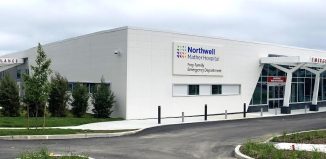SBU’s Arjun Venkatesan gathers information from wastewater

By Daniel Dunaief
One person’s toilet flush is another’s pool of information.
Arjun Venkatesan, Associate Director for the New York State Center for Clean Water Technology at Stony Brook University, has gathered information from wastewater plants to search for traces of opioids and other chemicals.
Such monitoring is a “great tool” and relies on the sensitivity of the method, Venkatesan said.
Indeed, other scientists, including Professor Christopher Gobler, Endowed Chair of Coastal Ecology and Conservation at the School of Marine and Atmospheric Sciences at Stony Brook, have used wastewater monitoring to collect information about the prevalence of Covid-19 in a community.
Gobler explained that such monitoring has proven to be an “ideal way to track community infections. Through early to mid 2022, positive test rates and wastewater virus levels tracked perfectly. Since then, people began home testing and now, wastewater epidemiology is probably our best sign of community infection rates.”
In a joint effort through the Center for Cleanwater Technology, Venkatesan’s team monitors for chemicals, including opioids and other drugs. Such tracking, which college campuses and local governments have done, does not involve gathering information from any specific home. Instead, the scientists take anonymous samples from a larger dorm or a neighborhood, hoping to track changes in the presence of chemicals or a virus to enable health care mitigation efforts.
Venkatesan has been looking at common over-the-counter drugs and anti-viral treatments that residents used to treat Covid-19 infection, particularly before the development and distribution of several vaccines. He noticed an increase in over the counter use that matched the increase of Covid cases, which suggested that the infected people took these pain medicines for their symptoms first.
Venkatesan’s group monitored the use of these drugs over the last two years to confirm the trends. This baseline allowed him to “see increasing trends” in usage, he said. The increase “clearly indicates something more than what the drugs are regularly used for.”
Opioids
Venkatesan’s group has been working with the Department of Health to develop standard protocols to measure drugs at these sewage treatment plants. The testing needs to be updated to account for changes in consumption of new drugs that are being synthesized.
Each sample Venkatesan and his colleagues collect typically has hundreds of thousands of people in it, because the treatment plants process sewage for a large collection of communities. “This keeps anonymity,” he said. “We don’t want to dig up [information] from a single family home.”
The method is also cost effective when a single sample represents a larger population. This kind of information, however, could help public health professionals monitor the presence of drugs broadly in a community, providing them with a way to track the prevalence of addictive and potentially harmful drugs.
Venkatesan is developing methods to track fentanyl, a highly addictive drug linked to numerous deaths throughout the country and the world. Studies in other regions have demonstrated elevated levels of this drug.
Venkatesan said New York State responded to the pandemic by developing surveillance over the last few years. The approach was not well known and was limited mostly to illicit drugs. The pandemic made a significant impact, which helped officials appreciate the value of such a tool.
The state could also theoretically monitor for any chemicals that are stable enough in sewage.
While Venkatesan hasn’t measured traces of alcohol at sewage treatment plants, researchers and public health officials could create a screen to measure it. He was involved in a study that monitored for alcohol and nicotine consumption in many cities. “We could get interesting trends and understand community and population health in a better way,” he said. The pandemic has “helped establish the importance of this network.”
Surveys in which people call and ask about the consumption of drugs or alcohol can contain self-reporting error, as respondents may not know exactly how much they drink or may be reluctant to share those details.
Wastewater monitoring could capture trends, including whether communities have a spike in the use of drugs or alcohol on Friday nights or on weekends.
The Centers for Disease Control and Prevention created standardized methods for monitoring Covid-19 in the wastewater of cities and states.
Wastewater monitoring techniques are different for detecting viruses compared to chemicals. Venkatesan’s group is developing different method to screen for opioids. “We are excited about it,” he said. “Hopefully, next year, we should be able to monitor communities.”
As long as the sampling doesn’t cross any predetermined ethical line, monitoring could provide an effective way of looking at the trends and data, he said.
With so much water flowing through pipes and treatment plants, one of the biggest challenges in these efforts is to understand variables that affect what the scientists are monitoring.
The time between when a toilet is flushed in an apartment to the time when it reaches a plant can vary, depending on numerous variables, which creates uncertainty in the data.
To reduce this variability, scientists could do some sampling in manholes, between treatment plants.
Scientific roots
Venkatesan took an elective at the end of college in environmental science when he attended Anna University in Chennai, India. It was the first time he observed a wastewater treatment plant.
Fascinated by the process, he earned a Master’s in Environmental Engineering at the University of Nevada, Las Vegas and then went on to get a PhD at Arizona State. He also did his post doctoral research in Arizona.
Stony Brook was looking for a scientist to screen for contaminants in drinking water, including PFAS chemicals, which is a group of chemicals that are stable, hard to break down and are linked to thyroid cancer, among others.
PFAS chemicals are used in cleaners, textiles, fire-fighting foam and other applications.
Venkatesan leads drinking water efforts, while waste water epidemiology remains an ongoing project of interest.
Gobler hired Venkatesan five years ago to help run and then to exclusively run the drinking water initiative at Stony Brook.
Through the process, Venkatesan has “brought new insights and research programs related to wastewater epidemiology, bisolids and many other topics,” Gobler explained. Venkatesan has “exceeded expectations,” as he transitioned from a postdoctoral researcher to become Associate Director for Drinking Water Initiatives.”
Gobler called his colleague a “complete professional” who is “very positive and a good person to work with.”
In his research, Venkatesan develops technologies to remove these PFAS chemicals, while monitoring is also a part of that effort. Activated carbon filters can remove these chemicals from groundwater. These filters, however, require frequent replacement. Venkatesan is exploring ways to improve the life of the carbon filter.
PFAS chemicals make rain water unsafe to drink. Removing PFAS chemicals is an “important research topic locally and globally.”






